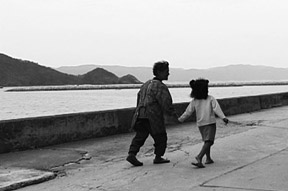Nuchigafu—Life Is a Treasure “Gyokusai” Stories in the Battle of Okinawa
(Nuchigafu—Gyokusai-ba kara no shogen) JAPAN / 2012 / Japanese, Korean, Okinawan / Color, B&W / Blu-ray / 132 min
JAPAN / 2012 / Japanese, Korean, Okinawan / Color, B&W / Blu-ray / 132 min
Director: Park Soo-nam
Photography: Otsu Koshiro, Teruya Shinji
Editing: Ueshima Hiroyuki, Omata Takayuki
Sound: Okui Yoshiya, Moromi Osato
Music: Hara Masami
Production Coordinator: Yasui Yoshio
Sound Editor: Katto Isamu, Hiyoshi Hiroshi
Assistant Director: Park Maeui
Production Company: Park Soo-nam, Song of Arirang Production Committee
Director Park Soo-nam reconstructs the narrative of the Okinawan gyokusai—the group suicides ordered by the military during the Second World War—from interviews with survivors from the Kerama Islands, and the military laborors who came to Okinawa from Korea. Gyokusai, the final sacrifice of life in opposition of Japan’s enemies, is not simply suicide. Park examines and compiles the issues surrounding the Okinawa gyokusai over many years. Examples include the lawsuit brought by former commanders of the Japanese Imperial Army against writer Oe Kenzaburo and the publishing house Iwanami Shoten, arguing that gyokusai was not an order issued by the army, as well as the subsequent editing of textbooks to remove mentions of gyokusai being a military command. This documentary brings the difficulties and pain experienced by the Okinawan and Korean people to light. Twenty years after Song of Arirang: Voices from Okinawa first captured a look at the Okinawan people, Nuchigafu offers us a rare view into the passage of time using archival footage from its preceding work.
 [Director’s Statement] On March 26th, 1945, the American forces landed on the Kerama Islands a week before they landed on the Okinawan main island. The inhabitants of the Kerama Islands at first cheered at the numerous ships filling the channel and the aircraft filling the skies, mistaking them for the Japanese military, yelling, “Hooray for the Emperor!” The people of the islands were certain the godly empire of Japan would be victorious in its war, and did not expect the massive fleet to be the enemy. When they found out it was the “American barbarians,” tragedy unfolded by order of the Japanese Imperial Army, as wife, daughter, and child were killed in the name of gyokusai. The Japanese Imperial Army had not only ordered the islands’ inhabitants to murder each other, but twice planned to massacre the five-hundred refugees on Aka Island. This plan was discovered by the islanders, leading to the majority of them fleeing to the Americans for protection.
[Director’s Statement] On March 26th, 1945, the American forces landed on the Kerama Islands a week before they landed on the Okinawan main island. The inhabitants of the Kerama Islands at first cheered at the numerous ships filling the channel and the aircraft filling the skies, mistaking them for the Japanese military, yelling, “Hooray for the Emperor!” The people of the islands were certain the godly empire of Japan would be victorious in its war, and did not expect the massive fleet to be the enemy. When they found out it was the “American barbarians,” tragedy unfolded by order of the Japanese Imperial Army, as wife, daughter, and child were killed in the name of gyokusai. The Japanese Imperial Army had not only ordered the islands’ inhabitants to murder each other, but twice planned to massacre the five-hundred refugees on Aka Island. This plan was discovered by the islanders, leading to the majority of them fleeing to the Americans for protection.
In 1992 I reached out to six Korean survivors who served in the Imperial Army and some family members of those who had passed away. I then searched for and studied sites where workers hired by the army were pressed to conduct suicide attacks against American positions, and the bunkers that held civilians captive and later became the places for their mass slaughter. I also collected eyewitness accounts of the most violent battles in the central part of the Okinawa Island, where Korean military laborors and Okinawan boys serving as soldiers strapped bombs to themselves and were forced to commit suicide attacks against American tanks. I was also able to collect the account of a cave called Abuchiragama in the south of the island. The island was the site where young “comfort women” were shot to death by the Japanese Imperial Army. In the second half of the film, I meet the younger sister of the former vice-mayor of Zamami, who offers testimony on the lawsuit that erased the association of gyokusai as a military order as nothing more than a fabrication. Who orchestrated the cover-up and revision of the responsibility for the Battle of Okinawa? This question will be the subject of Nuchigafu Part 2, now in production.
 Park Soo-nam
Park Soo-nam
Born 1935 in Mie Prefecture. A Japanese born Zainichi Korean, Park Soo-nam is committed to working on issues of racial discrimination. As a writer, she has published The Collected Letters of Ri Chin’u (1979), chronicling the infamous juvenile defendant of the 1958 Komatsugawa Case. In 1965, Park travelled to Hiroshima to interview her fellow Korean countrymen who had fallen victim to the nuclear blast to publish Korea, Hiroshima, Half-Japanese (1973) and The Other Hiroshima (1982). Park continued her work, releasing the documentaries The Other Hiroshima: Korean A-bomb Victims Tell Their Story (1987) and Song of Arirang: Voices from Okinawa (1991). These two films were screened independently across Japan to a strong response, and were featured at YIDFF 2005. Since 2006, Park has been working on her Nuchigafu documentary series, completing Part I in 2012.
